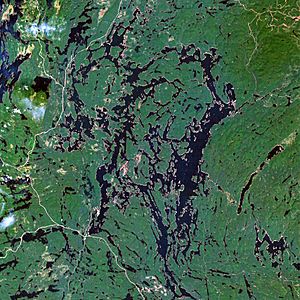Cabonga Reservoir facts for kids
Quick facts for kids Cabonga Reservoir |
|
|---|---|
 |
|
| Location | Lac-Pythonga and Réservoir-Dozois, La Vallée-de-l'Or Regional County Municipality, Quebec |
| Coordinates | 47°19′57″N 76°34′37″W / 47.33250°N 76.57694°W |
| Type | Artificial |
| Primary inflows | Cabonga River |
| Primary outflows | Gens de Terre River Ottawa River |
| Basin countries | Canada |
| Surface area | 677 km2 (261 sq mi) |
| Shore length1 | 4,500 km (2,800 mi) |
| Surface elevation | 361 m (1,184 ft) |
| 1 Shore length is not a well-defined measure. | |
The Cabonga Reservoir (which is called Réservoir Cabonga in French) is a very large, man-made lake in central Quebec, Canada. It covers a huge area of about 677 square kilometers (261 square miles). This big lake is located right on the edge of two unorganized territories, Lac-Pythonga and Réservoir-Dozois. It is also completely inside the La Vérendrye Wildlife Reserve, which is a protected natural area. A First Nations community called Rapid Lake lives on the western side of the reservoir.
The name "Cabonga" comes from the Algonquin language. In Algonquin, the word kakibonga means "completely blocked by sand." This name likely describes how the area looked before the reservoir was created.
The Cabonga Reservoir has two main ways for water to flow out. One is the Gens de Terre River, which flows to the south-east. This river eventually joins the Gatineau River. The other outflow goes to the north-west, directly into Barrière Lake, which is part of the Ottawa River system. Both of these outflows have dams that help control how much water flows out of the reservoir into the rivers.
Many fishing experts and magazines say that Cabonga Reservoir is one of the best places in North America to catch walleye and northern pike. Outdoor Canada magazine even listed it as one of the "simply the best" spots for catching lake trout.
Contents
History of Cabonga Reservoir
Before the Cabonga Reservoir was created, the area was home to a large natural lake called Lake Cabonga. This lake was considered the biggest body of water between the Gatineau and Ottawa Rivers.
Early Trading Post
In 1851, the Hudson's Bay Company set up a trading post on this lake. At that time, the lake was known as Kakabonga. This trading post was important for trade in the region. However, it burned down in 1873. Instead of rebuilding it in the same spot, a new trading post was built on nearby Barrière Lake.
Creating the Reservoir
Later, in 1928 and 1929, a dam was built at the start of the Gens de Terre River, which was the natural outlet of the lake. The main reason for building this dam was to create a large water reserve. This reserve was used by logging companies to help them float their cut logs downstream to sawmills.
When the dam was built, it caused the water level to rise significantly. This rise in water combined about 37 natural lakes into one very large reservoir. The new reservoir covered an area of about 404 square kilometers (156 square miles). It became dotted with countless islands, some of which are quite large, and many deep bays.
How the Name Changed
In 1864, a surveyor named H. C. Symmes used the name "Kakibonga" in his report to describe the lake. By 1911, some maps still called it "Lake Kakabonga." Finally, in 1924, a group called the Commission de Géographie officially approved the name "Cabonga" for the reservoir, which is what it is called today.
Fish Species in Cabonga Reservoir
The Cabonga Reservoir is home to many different kinds of fish. If you go fishing there, you might catch:


